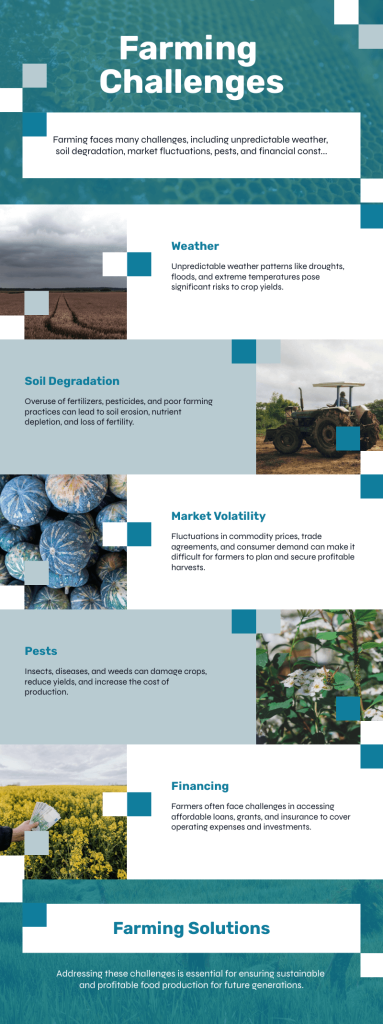Farmers are the backbone of the agricultural industry, but their work is not without challenges. From unpredictable weather to market volatility, farmers face numerous obstacles that require resilience and strategic planning. Here are the top five challenges farmers face and practical ways to overcome them.

1. Unpredictable Weather Patterns
Weather extremes, such as droughts, floods, and unseasonal frost, can devastate crops and livestock. Climate change has only exacerbated these issues.
Solutions:
- Diversify Crops: Plant a mix of crops to reduce dependency on one.
- Invest in Irrigation: Modern irrigation systems help combat droughts.
- Use Technology: Weather forecasting apps and tools can provide timely warnings.
2. Soil Degradation
Continuous farming without proper soil care leads to nutrient depletion, erosion, and reduced productivity.
Solutions:
- Adopt Conservation Practices: Techniques like crop rotation and cover cropping preserve soil health.
- Use Organic Fertilizers: Enrich soil with natural composts and manures.
- Test Soil Regularly: Soil tests help identify nutrient deficiencies.
3. Market Volatility
Fluctuating prices for crops and livestock make it difficult for farmers to predict income and plan expenses.
Solutions:
- Engage in Contract Farming: Secure guaranteed prices with buyers beforehand.
- Diversify Income Streams: Include secondary sources like agritourism or value-added products.
- Monitor Market Trends: Stay informed about price trends and consumer demands.

4. Pests and Diseases
Pests and diseases can destroy entire harvests, reducing yields and profitability.
Solutions:
- Use Integrated Pest Management (IPM): Combine natural predators, crop rotation, and judicious pesticide use.
- Invest in Resistant Varieties: Choose seeds and breeds that are resistant to local pests and diseases.
- Maintain Biosecurity: Prevent disease spread through hygiene and quarantine measures.
5. Access to Financing
High costs of equipment, seeds, and fertilizers often strain farmers who lack adequate financial resources.
Solutions:
- Explore Subsidies and Grants: Governments and NGOs offer financial aid for farming needs.
- Partner with Cooperatives: Join agricultural cooperatives for shared resources and better credit options.
- Leverage Microfinance: Small loans with flexible terms can help manage short-term needs.

Conclusion
While farming is fraught with challenges, these obstacles are not insurmountable. By adopting modern technology, diversifying practices, and staying informed, farmers can build resilience against uncertainties and achieve sustainable success. With the right strategies, the agricultural sector can thrive despite its difficulties.


Leave a Reply